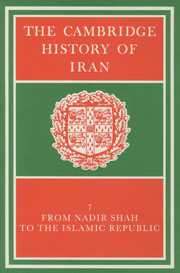Book contents
- Frontmatter
- PART 1 THE POLITICAL FRAMEWORK, 1722–1979
- PART 2 FOREIGN RELATIONS
- PART 3 ECONOMIC AND SOCIAL DEVELOPMENTS
- PART 4 RELIGIOUS AND CULTURAL LIFE, 1721–1979
- 19 RELIGIOUS FORCES IN EIGHTEENTH- AND NINETEENTH-CENTURY IRAN
- 20 RELIGIOUS FORCES IN TWENTIETH-CENTURY IRAN
- 21 POPULAR ENTERTAINMENT, MEDIA AND SOCIAL CHANGE IN TWENTIETH-CENTURY IRAN
- 22 PRINTING, THE PRESS AND LITERATURE IN MODERN IRAN
- 23 PERSIAN PAINTING UNDER THE ZAND AND QĀJĀR DYNASTIES
- 24 THE ARTS OF THE EIGHTEENTH TO TWENTIETH CENTURIES
- Genealogical tables
- Bibliographies
- Index
- References
23 - PERSIAN PAINTING UNDER THE ZAND AND QĀJĀR DYNASTIES
from PART 4 - RELIGIOUS AND CULTURAL LIFE, 1721–1979
Published online by Cambridge University Press: 28 March 2008
- Frontmatter
- PART 1 THE POLITICAL FRAMEWORK, 1722–1979
- PART 2 FOREIGN RELATIONS
- PART 3 ECONOMIC AND SOCIAL DEVELOPMENTS
- PART 4 RELIGIOUS AND CULTURAL LIFE, 1721–1979
- 19 RELIGIOUS FORCES IN EIGHTEENTH- AND NINETEENTH-CENTURY IRAN
- 20 RELIGIOUS FORCES IN TWENTIETH-CENTURY IRAN
- 21 POPULAR ENTERTAINMENT, MEDIA AND SOCIAL CHANGE IN TWENTIETH-CENTURY IRAN
- 22 PRINTING, THE PRESS AND LITERATURE IN MODERN IRAN
- 23 PERSIAN PAINTING UNDER THE ZAND AND QĀJĀR DYNASTIES
- 24 THE ARTS OF THE EIGHTEENTH TO TWENTIETH CENTURIES
- Genealogical tables
- Bibliographies
- Index
- References
Summary
During the late 17th and early 18th centuries Persian painting was passing through a difficult stage. Just as in the Mongol period of the 14th century Persian artists were busy absorbing Chinese ideas and conventions, so in our period they were struggling to accommodate themselves to the artistic canons of Europe. We cannot blame them, however deplorable the tendency may seem; increasing contact with Europe made such a development inevitable. It was, indeed, going on simultaneously all over the East, and leaving its mark on various Asian schools of painting. In the hermit empire of Japan European scientific books and engravings of all kinds were eagerly sought and smuggled in through the Dutch traders in the face of official disapproval. By the end of the 18th century they were being regurgitated in Japanese popular form, and landscape prints attempting European perspective and atmospheric effects were designed by Toyoharu, Hokuju, and others. In China the same influences flowed into the open port of Canton, where many Chinese painters were busily producing pictures for the western market (a side-line to the tea trade) in which the native style is considerably modified by European ideas of perspective, modelling, and drapery. They vary enormously in quality, and were generally produced in series - court costumes, trades, boats on the Yang-tze, and even tortures - but no educated Chinaman of the time would have regarded them as true paintings. In India, too, the period 1750–1850 was the heyday of “Company Painting”, usually practised under direct English patronage, and devoted to the illustration of local types, castes, religious festivals, fauna, flora, and topography, in a more or less westernized style.
- Type
- Chapter
- Information
- The Cambridge History of Iran , pp. 870 - 889Publisher: Cambridge University PressPrint publication year: 1991

